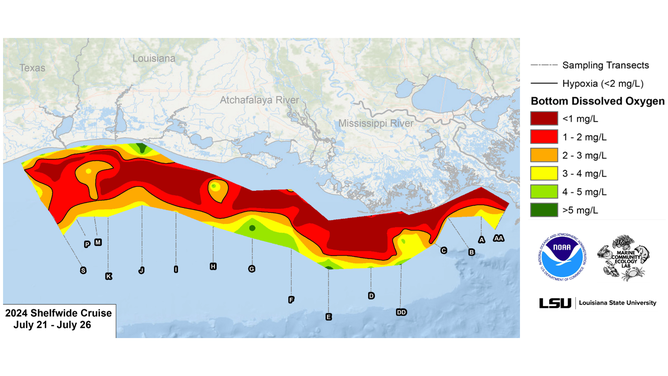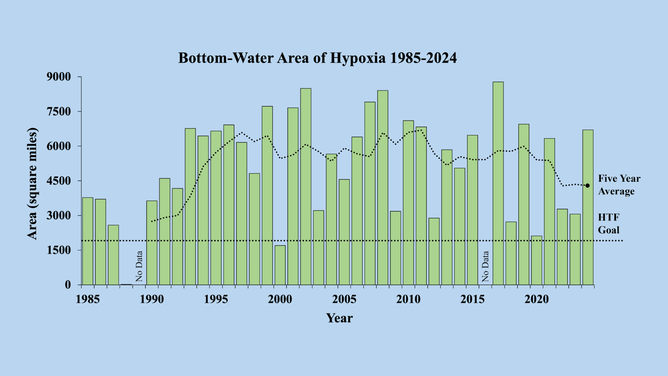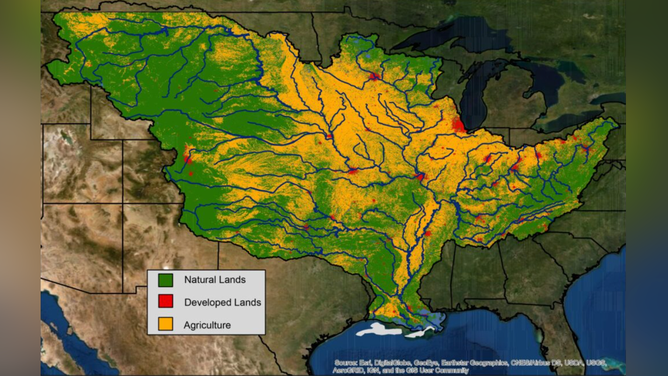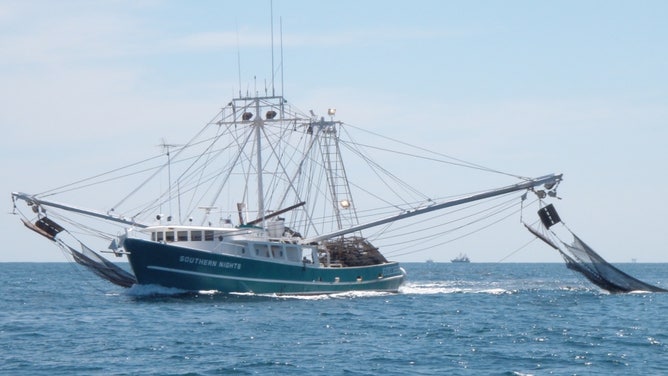‘Dead zone’ in Gulf of Mexico now the size of New Jersey, scientists say
A dead zone is an area where oxygen levels in the water are so low that it is potentially deadly for marine life.
FILE: Two divers rescued after spending nearly 40 hours floating in Gulf of Mexico
The U.S. Coast Guard announced that two missing divers were found 15 miles off the southeast Texas coastline.
NOAA announced Thursday that their annual measurement of the largest dead zone in U.S. waters, the Gulf of Mexico dead zone, is roughly the size of New Jersey.
A dead zone is an area where oxygen levels are so low that its waters are potentially deadly for marine life, NOAA said.
Located largely off the coast of Louisiana, the Gulf of Mexico dead zone forms every summer due to nutrient-rich runoff from the Mississippi River Basin and the explosive algae blooms they trigger, according to the EPA.

Map of measured Gulf hypoxia zone, July 21–26, 2024. Red area denotes 2 mg/L of oxygen or lower, the level which is considered hypoxic, at the bottom of the seafloor.
(LUMCON / LSU / NOAA)
A team of scientists from Louisiana State University and Louisiana Universities Marine Consortium led this year's survey from July 21-26. Their track and measurements can be seen in the map above.
MASSIVE FISH KILL IN TEXAS CREATES WAVES OF DEAD FISH, WASHING SHREDDED SKELETONS ASHORE
They found that the dead zone has grown this summer to be more than 6,700 square miles or more than 4 million acres of habitat, making it the 12th largest it has been in NOAA’s 38 years of measurements.

Long-term measured size of the hypoxic zone (green bars) measured during the ship surveys since 1985, including the target goal established by the Mississippi River/Gulf of Mexico Watershed Nutrient Task Force and the 5-year average measured size (black dashed lines).
(NOAA)
"The area of bottom-water hypoxia was larger than predicted by the Mississippi River discharge and nitrogen load for 2024, but within the range experienced over the nearly four decades that this research cruise has been conducted," said Nancy Rabalais, Ph.D. professor at Louisiana State University and the Louisiana Universities Marine Consortium and co-chief scientist for the survey cruise.
"We continue to be surprised each summer at the variability in size and distribution," she added.

The Gulf of Mexico dead zone is featured here in gray. The Mississippi River watershed, which encompasses over 40% of the continental U.S and crosses 22 state boundaries, is made up of farms (yellow), cities (red), and natural lands (green). Nitrogen and phosphorus pollution in runoff and discharges from agricultural and urban areas are the major contributors to the annual summer hypoxic dead zone in the Gulf of Mexico.
(USGS / NOAA)
Dead zones are a significant factor in assessing the health of a marine ecosystem, along with the economic ramifications of an unhealthy or disrupted ecosystem.
As nutrient pollution in the water triggers algae overgrowth, the algae then die and deplete oxygen in the water as they decompose. NOAA said this oxygen depletion forces marine animals, such as fish and shrimp, to leave the area.

A shrimp boat trawls for shrimp in the Gulf of Mexico.
(NOAA Fisheries / NOAA)
Scientists have also found that areas with low oxygen levels alter the lives of marine life that remain in those waters. NOAA noted that some of those changes involve the fish’s diets, growth rates, reproduction and habitat use. In turn, this impacts how many commercially harvested animals, such as shrimp, are available.
More than 500 dead zones exist throughout the world, according to the United Nations. These areas threaten tens of billions of dollars in economic costs each year.
